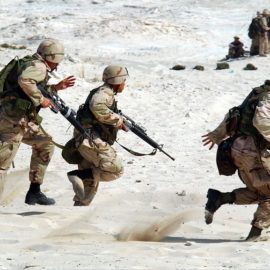

This article is an excerpt from the Shortform book guide to "The Bottom Billion" by Paul Collier. Shortform has the world's best summaries and analyses of books you should be reading.
Like this article? Sign up for a free trial here .
What’s the conflict trap? What causes conflict in developing nations?
In his book The Bottom Billion, economist Paul Collier explains that one big reason why many poor countries stay poor is because of conflict. This conflict is often fueled by low income, slow growth, and natural resource dependence.
Continue reading to learn about the conflict trap, according to Collier.
The Conflict Trap
The first of Paul Collier’s poverty traps is called the conflict trap. Specifically, Collier focuses on civil wars and coups d’etat, which affect (or have recently affected) about 70% of the bottom billion, causing dramatic harm. Aside from the human costs, this violence reduces economic growth, scares off potential investors, and causes people (and their money) to flee. To Collier, reducing the prevalence of conflict is essential to elevating the bottom billion out of poverty.
Causes of Conflict
Collier and his researchers designed a model to uncover the causes of conflict in developing nations. Among others, they measured variables like income, growth rates, income inequality, and ethnic composition to determine which factors increased the likelihood of conflict. In their analysis, they distinguished between civil wars and coups d’etat: For conflicts that lead to civil war, they discovered three main culprits: low income, slow growth, and natural resource dependence; for coups, Collier found that low income and stagnant growth are also the main predictors of government overthrow.
1. Low income: For a given nation, if current income is doubled, the risk of civil war is cut in half.
(Shortform note: For example, the Central African Republic currently has GDP per capita of $493. If this were to be raised to $986, the country would be half as likely to fall into civil war, according to Collier’s model.)
2. Slow growth, or economic decline: Each percentage point of GDP reduction increases civil war risk by a percentage point.
(Shortform note: While economic growth may reduce the likelihood of war, it can’t prevent it altogether. Ethiopia is currently engulfed in civil war in its Tigray region, despite sustained growth rates of more than 6% annually since 2004.)
3. Natural resource dependence: The more a nation depends on revenue from natural resources, the greater the threat of civil war. Collier suggests that this is because rebels are more likely to take the risk of war to get their hands on the glut of natural resource money.
(Shortform note: Research by UCLA Professor Michal Ross cites natural resources—particularly oil and minerals—as having a key role in ”triggering, prolonging, and financing” civil wars.)
Collier’s findings contradict what many policymakers assume leads to civil war: income inequality, political repression, and a colonial legacy. Collier found these factors didn’t affect the likelihood of civil war one way or the other.
Ethnic diversity is another often-mentioned potential cause of conflict. But Collier found an increased risk of conflict only in societies with one ethnic group large enough to form a majority. This majority could oppress smaller groups through majority rule, leading to tension and eventual war.
(Shortform note: The Rwandan Civil War of 1990-1994 is a well-known example of conflict influenced by ethnic strife. The Hutu majority marginalized the Tutsi minority, which eventually took up arms against the government, leading to civil war.)
| Collier’s Methodology Criticized Most of Collier’s ideas on conflict come from a 2003 report he wrote for the World Bank called Breaking the Conflict Trap. Although the report has influenced policymakers at the World Bank and elsewhere, some scholars have criticized its methodology. Laurie Nathan of the London School of Economics published a paper titled “The Causes of Civil War: The False Logic of Collier and Hoeffler,” in which he accuses Collier of empirical mistakes that cast doubt on the validity of his conclusions about both the causes of war and the best strategies to prevent violence. For example, Nathan criticizes Collier for treating all civil wars the same rather than considering their variable intensity and scope, and for neglecting to consider the social and political factors that led to the conflicts. |

———End of Preview———
Like what you just read? Read the rest of the world's best book summary and analysis of Paul Collier's "The Bottom Billion" at Shortform .
Here's what you'll find in our full The Bottom Billion summary :
- How development aid programs pay too little attention to struggling countries
- A look at the four poverty traps, and the four remedies for them
- How conditions for the bottom billion are changing






